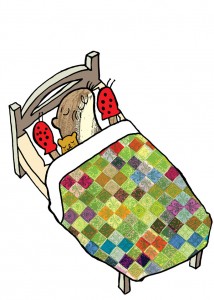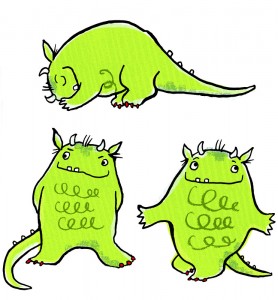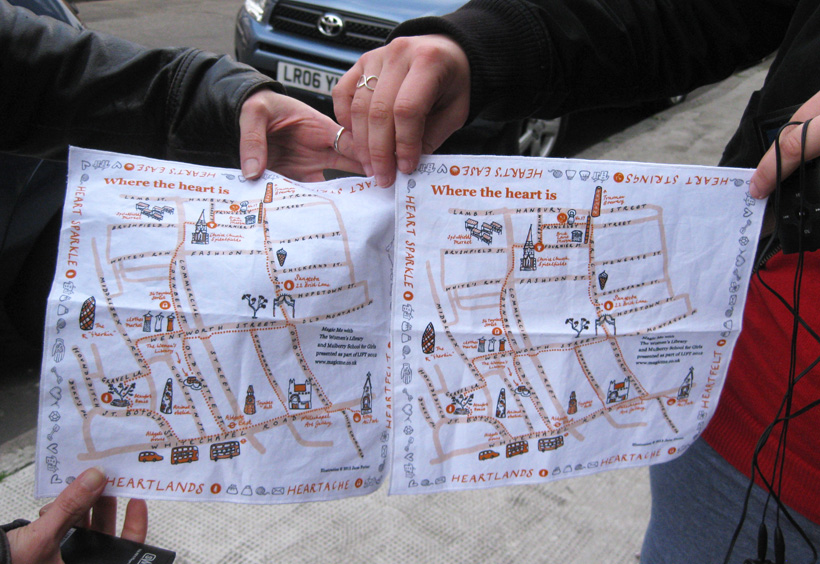Here’s a sleeping otter who’s very pleased with his new mittens…
Author Archives: Jane Porter
Little monsters
Leaves within leaves – a Denys Lasdun mural
How do you get nearly 600 children to participate in a school mural project? That was the challenge to be tackled when Hallfield Primary School in Bayswater invited me to come and fill some empty display boards in one of their curving corridors. The school was designed in 1951 by architect Denys Lasdun to be filled with light, curved spaces and tree-filled courtyards – it is a real gem. Lasdun’s original concept drawings for the school showed the classrooms as leaves, dining area as pea pods and hall space as a flower. This seemed a good starting point for the mural – a black and white outline over blocks of colour, with a leaf for each class just as Lasdun had planned – except that now there are 24 classes in the school.
Over the last couple of weeks the teachers have been working with their classes to make leaves using different media and carefully controlled colour palettes so hat the resulting leaves could be divided into four seasons. The result was hundreds of miniature works of art, in pastel lines over painted patterns, printed from real leaves, in pen, collage and chalk. I used hairspray to fix chalk and pastels, but charcoal was a bit more challenging. I’d also recommend checking any marker pens for bleed first. Having painted the background shapes I then used pva to glue all the small leaves within the big leaves – and now it’s finished.
I’d been at the school in February for a drawing project and it was lovely to be remembered by lots of the children. I also enjoyed hearing them rehearse their school production of ‘Skellig’ while I worked.
Wild, wild men – and a grunting boy
Sometimes it’s good to do something completely different, out of the studio, and away from briefs and projects. And if it involves a tall hairy man with giant feet and a penchant for bananas, so much the better. This summer the Hayward Gallery is running a Wide Open School – the gallery’s take on adult education, where artists lead creative sessions on a weird and wonderful range of topics. But probably none is more weird or indeed wonderful than the Wild Man Life Drawing workshop which took place today, led by illustrator and printmaker Stephen Fowler.
With an incredibly eclectic soundtrack of birdsong, folksong and 50s B-movie soundtracks, we set to work with charcoal and pencils capturing first silhouettes then the whole figure of our grunting, hirsute wild man – who was soon joined by a silken haired bigfoot, striking poses with sticks, skulls…and bananas. The piece de resistance was the wild boy, who had been looking forward to his role for weeks and revelled in a variety of poses, accompanied by suitably wild squeaks and groans.
Sheets of drawings soon lined the walls as one quick pose followed another. I really enjoyed being immersed in this most unusual of drawing environments, and ended up with sheets of potential characters. You can read more about wild man drawing on Stephen’s blog here.
A map on a handkerchief
 I had an unusual commission earlier this year – to design a map for a handkerchief. It came from the intergenerational arts organisation Magic Me, who do wonderful projects in the East End of London linking up older and younger people, getting them to share stories and explore ideas together.
I had an unusual commission earlier this year – to design a map for a handkerchief. It came from the intergenerational arts organisation Magic Me, who do wonderful projects in the East End of London linking up older and younger people, getting them to share stories and explore ideas together.
Yesterday I had the chance to attend the rehearsal for ‘Where the Heart Is’, a tour (guided by handkerchief) of six locations around Whitechapel where films are showing, to be accompanied by podcasts, of the love stories of a group of girls from Mulberry School and some lovely older ladies who have lived in the area for most or all of their lives. I really enjoyed chatting over a cup of tea to the regulars from the group, then listening to the recordings of their conversations with the girls, interspersed with singing and carefully chosen sound effects. Each of the six recordings is based on a different type of love – romantic, family, home etc, and they are all very moving. You can find out more – or even book a place for the tour which includes tea and cake – at LIFT 12. The group were also on Women’s Hour on Radio 4 today – you can listen again here.
Fretwork, light and lustrous prints
 On a busy, dusty bus-heavy road in Lambeth is a secret treasure – the house formerly lived in by Kenyan poet, author and daytime civil servant Khadambi Asalache. When he died he left his house to the National Trust, and it’s a magical space filled with 20 years-worth of hand-carved fretwork, and a collection of beautiful objects from all over the world, from African tapestries to 18th century lustre-ware.
On a busy, dusty bus-heavy road in Lambeth is a secret treasure – the house formerly lived in by Kenyan poet, author and daytime civil servant Khadambi Asalache. When he died he left his house to the National Trust, and it’s a magical space filled with 20 years-worth of hand-carved fretwork, and a collection of beautiful objects from all over the world, from African tapestries to 18th century lustre-ware.
I was very lucky to be invited to explore the house with groups of children from the neighbouring Heathbrook Primary School, and then work with them to create a set of printed postcards inspired by the house. In groups of 6, we stepped through the door into another world – the children remarked that it was like entering a fairy tale. Khadambi’s widow Susie welcomed the children and showed them round the exquisite rooms, where every surface was decorated with animals, swirls and patterns. The children took photographs, and back at the school we used computers to play with the images and alter them. Finally we used block printing and mono printing, informed by the photographic work, so that each child produced one piece of artwork celebrating the house. These were then made into a set of postcards which were printed up and presented to various people connected with the house.
The house is currently undergoing huge renovations because of structural problems: each individual piece of fretwork is being removed, labelled, and cleaned before being replaced in exactly the same position. Eventually the house will open to the public through the National Trust, by appointment as it is a small and delicate space. But it is well worth the effort.
Stepping through the door
This week I’ve been working at the Mall Galleries with schools visiting from nearby Lambeth. I devised a workshop for them which involved looking at the paintings on display and sketching their favourites, then using that to inspire a book based on magical, mystery doors. Working with Elli from the gallery, we pre-folded A2 paper into a simple book form, then showed the children what was possible with a demonstration book featuring doors peeping on to the next page. Then the children got to work with scissors, glue and a big selection of tempting collage materials, together with coloured pencils. The results were incredibly inventive, with several children going straight into 3-D and others showing a tremendous innate sense of colour and design. You can see the demonstrations book I made to show the children here.





















